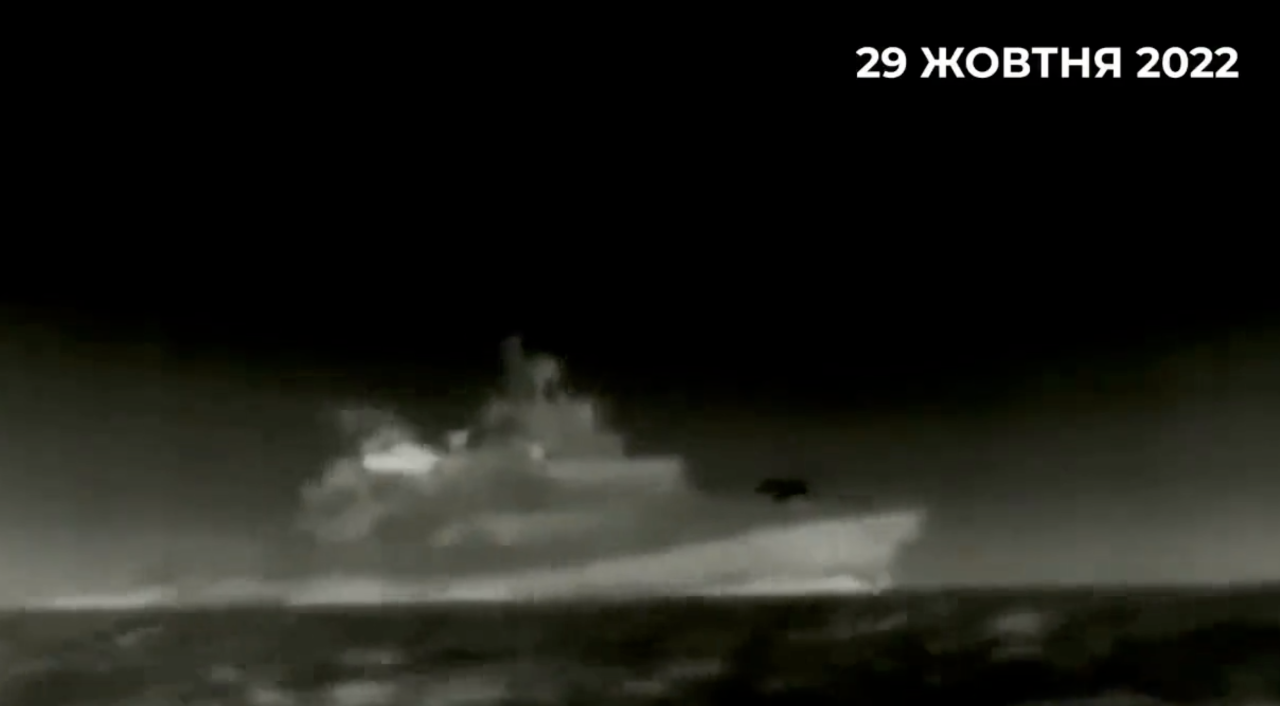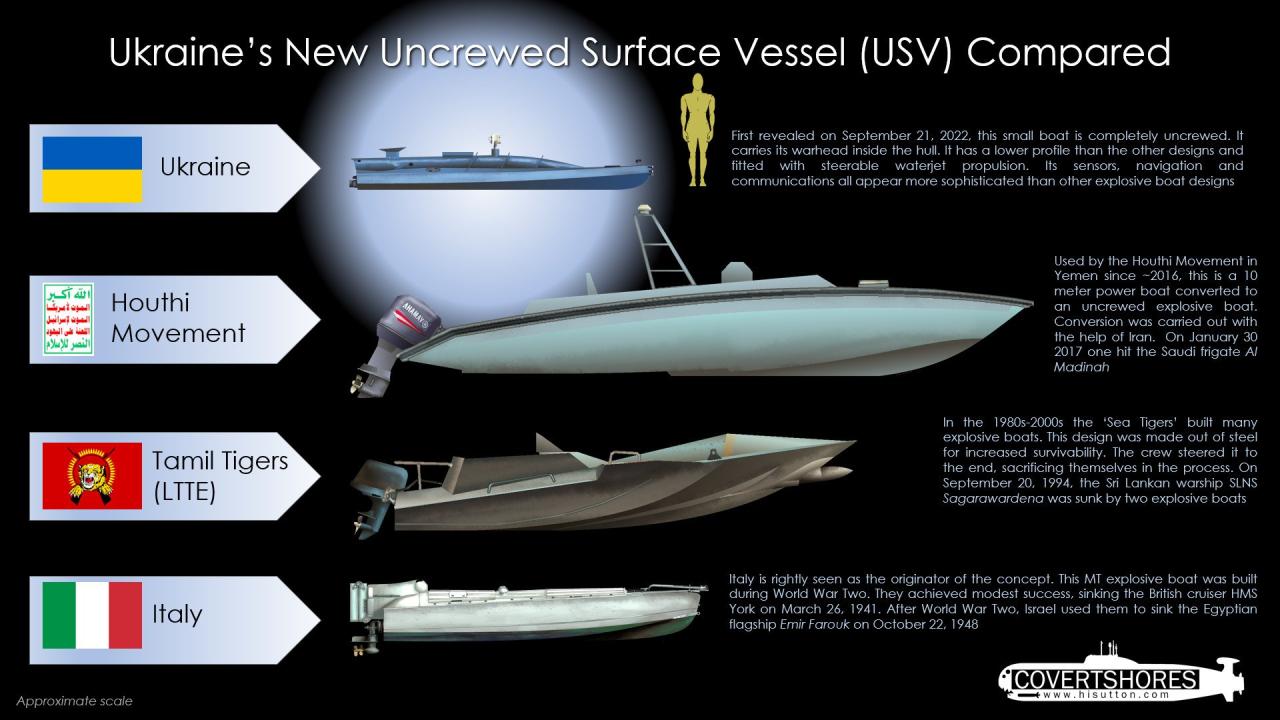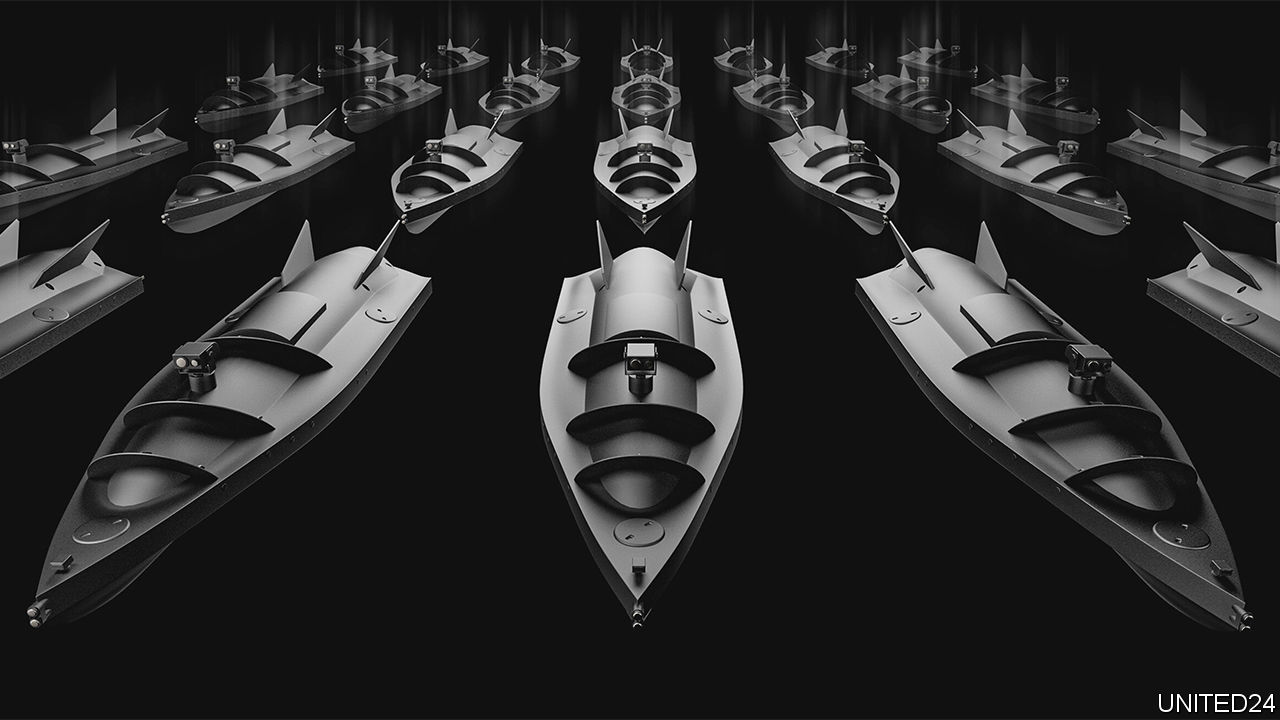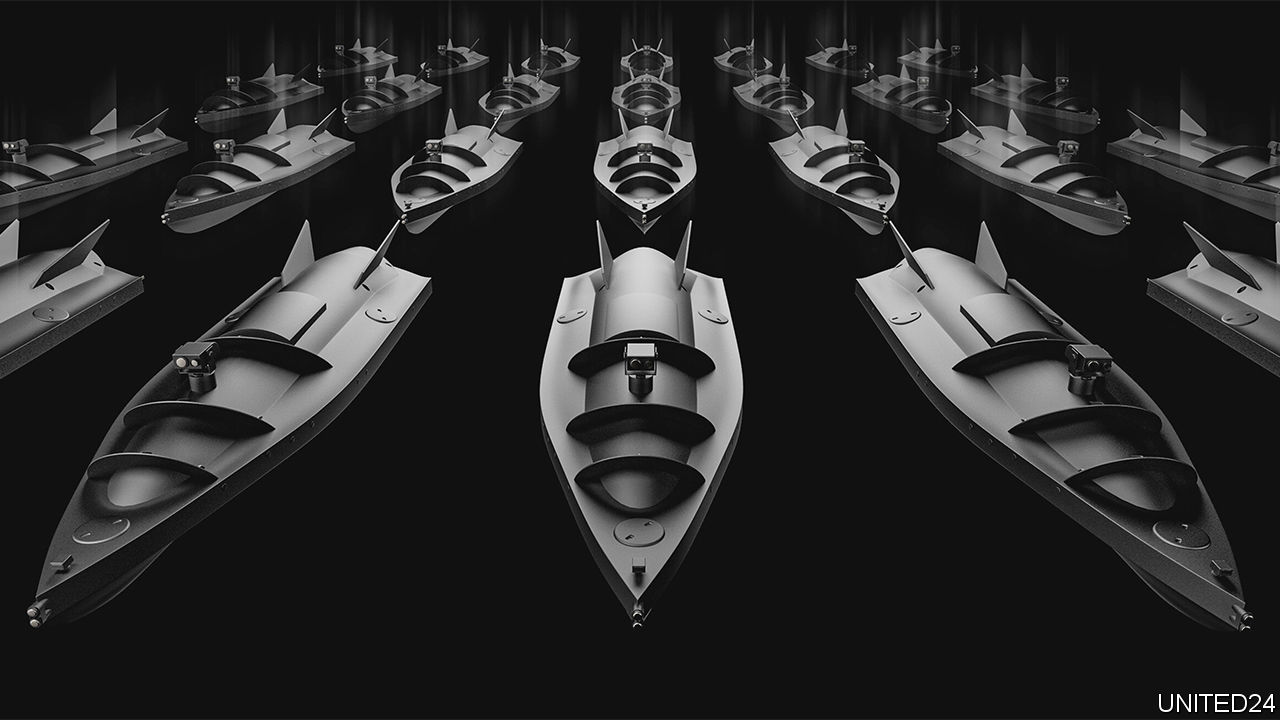Ukrainian sea drones are rapidly changing naval warfare. These unmanned vessels, packed with innovative technology, are proving surprisingly effective against larger, more traditional naval forces. Their relatively low cost, ease of deployment, and surprising capabilities are forcing a re-evaluation of naval strategy and tactics, both for Ukraine and its adversaries.
This exploration delves into the design, manufacturing, military applications, and ethical implications of Ukrainian sea drones. We’ll examine their technological advancements, compare them to similar systems from other nations, and analyze their impact on the geopolitical landscape. We’ll also consider the economic consequences of their development and deployment, and explore potential future scenarios for their use.
Ukrainian Sea Drone Technology: A Deep Dive

Ukraine’s burgeoning sea drone technology represents a significant shift in naval capabilities, particularly in the context of asymmetric warfare. This technology is rapidly evolving, showcasing innovative designs and impactful military applications. This article explores the current state, military applications, manufacturing processes, economic and political implications, ethical considerations, and a specific example of a Ukrainian sea drone.
Ukrainian Sea Drone Technology: Design, Materials, and Propulsion
Ukrainian sea drones vary in design, reflecting a pragmatic approach to leveraging readily available materials and technologies. Many designs incorporate modular components for ease of maintenance and repair. Common materials include fiberglass reinforced polymers for hulls, providing a balance of strength and weight efficiency. Propulsion systems often utilize electric motors powered by batteries, offering quiet operation and extended range compared to traditional combustion engines.
Some advanced models might incorporate hybrid systems combining electric propulsion with auxiliary power sources for longer missions.
Comparison of Ukrainian Sea Drone Technology with Other Nations

While exact specifications for many Ukrainian sea drones remain classified, comparing them with similar technologies from other nations provides valuable context. The table below offers a general comparison, acknowledging that specific details are often unavailable due to security concerns.
| Country | Drone Type | Capabilities | Limitations |
|---|---|---|---|
| Ukraine | Various Unmanned Surface Vessels (USV) | Coastal patrol, reconnaissance, mine-laying, anti-ship attacks | Limited range for some models, vulnerability to anti-drone measures |
| United States | Various USVs (e.g., Sea Hunter) | Long-range anti-submarine warfare, mine countermeasures, intelligence gathering | High cost, complex maintenance |
| Israel | Protector USV | Maritime security, border patrol, anti-terror operations | Relatively smaller size, limited payload capacity |
| China | Various USVs | Anti-submarine warfare, intelligence gathering, coastal defense | Data on specific capabilities and limitations is often scarce |
Future Advancements in Ukrainian Sea Drone Technology
Future advancements likely involve integrating more sophisticated sensors, AI-powered autonomy, and improved communication systems. Increased range and payload capacity are also likely goals. Collaboration with international partners could accelerate technological development and provide access to advanced components and expertise.
Military Applications of Ukrainian Sea Drones
Ukrainian sea drones have demonstrated effectiveness in various naval warfare scenarios. Their quiet operation and relative affordability make them a potent tool in asymmetric warfare.
Tactical and Strategic Uses in Naval Warfare
Ukrainian sea drones have been employed for reconnaissance, mine-laying, and attacks against larger naval vessels. Successful deployments have included disrupting enemy naval operations and inflicting damage on warships and landing craft. Their strategic value lies in their ability to overwhelm enemy defenses through swarm tactics and their cost-effectiveness compared to manned vessels.
Effectiveness Against Various Naval Targets
While the exact details of engagements remain largely classified, reports indicate that Ukrainian sea drones have proven effective against a range of targets. Their ability to deliver explosive payloads makes them a significant threat to smaller vessels, while swarm tactics can potentially overwhelm larger ships’ defenses. Their low cost and ease of replacement makes them a potent tool even in high-risk operations.
Impact on Naval Doctrine and Strategy
The successful use of Ukrainian sea drones has forced a reassessment of naval doctrine and strategy. The vulnerability of larger, more expensive vessels to smaller, cheaper drones has highlighted the need for improved anti-drone defenses. The use of swarm tactics, and their ability to perform missions independently, is reshaping naval warfare.
Manufacturing and Deployment of Ukrainian Sea Drones
The manufacturing process involves a combination of domestic and potentially international sourcing of components. Logistical challenges in deployment and maintenance are significant but are being addressed through innovative solutions.
Manufacturing Process of Ukrainian Sea Drones
The manufacturing process typically involves the following steps:
- Design and prototyping
- Hull fabrication using fiberglass or other composite materials
- Integration of propulsion systems (electric motors, batteries)
- Installation of sensors and communication equipment
- Payload integration (explosives, cameras, etc.)
- Testing and quality control
Logistical Challenges in Deployment and Maintenance
Deploying and maintaining sea drones in operational environments presents significant logistical hurdles. These include the need for secure launch and recovery systems, reliable communication links, and effective maintenance procedures in challenging maritime conditions. The development of autonomous systems is reducing reliance on constant human oversight, but challenges remain.
Key Players in Design, Production, and Deployment
While specific details are often kept confidential, it’s understood that a combination of state-owned defense enterprises, private companies, and potentially international partners contribute to the design, production, and deployment of Ukrainian sea drones.
Economic and Political Implications
The development and deployment of Ukrainian sea drones have significant economic and geopolitical consequences. The relatively low cost of these systems provides a cost-effective defense option, while their strategic implications are far-reaching.
Ukrainian sea drones are proving surprisingly effective, showcasing the potential of smaller, autonomous naval platforms. Think about how this tech could evolve – imagine the dazzling light shows at the shanghai drone show 2035 , but instead of lights, it’s swarms of miniaturized, highly maneuverable naval drones. The future of naval warfare, and perhaps even entertainment, might be far smaller than we expect.
Economic Impact on the Ukrainian Economy
The development and production of sea drones stimulate economic growth by creating jobs in the defense industry and related sectors. Exports of this technology could further boost the Ukrainian economy.
Geopolitical Implications of Ukrainian Sea Drone Technology
The effective use of Ukrainian sea drones shifts regional power dynamics, particularly in the Black Sea region. Their relatively low cost and effectiveness provide a powerful tool for smaller nations to counter more powerful adversaries.
Potential Scenarios for the Future Role in International Relations
The widespread adoption of similar drone technology by other nations could lead to an arms race, necessitating international agreements on the responsible use of autonomous weapons systems. Ukraine’s experience could shape future international discussions on the regulation of such technologies.
Ethical Considerations of Ukrainian Sea Drones
The use of autonomous weapons systems raises significant ethical concerns, particularly regarding accountability and the potential for unintended harm. Careful consideration of these issues is vital.
Ethical Considerations Related to the Use of Autonomous Sea Drones in Warfare
Key ethical considerations include the lack of human control in targeting decisions, the potential for civilian casualties, and the difficulty in establishing accountability for actions taken by autonomous systems. International humanitarian law must be considered in the design and use of these technologies.
Ukraine’s naval capabilities are getting a serious boost thanks to their innovative sea drone program. These unmanned vessels are proving surprisingly effective, and you can learn more about their design and deployment by checking out this informative article on Ukrainian sea drones: ukrainian sea drone. Understanding this technology is key to grasping the evolving nature of modern naval warfare, particularly in the context of the ongoing conflict.
The future of naval combat might just depend on these little guys.
Ethical Implications Compared to Traditional Naval Weapons
Compared to traditional naval weapons, autonomous sea drones raise unique ethical challenges due to their potential for autonomous decision-making and the reduced human element in the targeting process. This necessitates stricter regulations and ethical frameworks.
Framework for Responsible Development and Use of Ukrainian Sea Drones

A robust framework for responsible development and use should incorporate international humanitarian law, strict guidelines for target selection, and mechanisms for oversight and accountability. This framework should prioritize minimizing civilian casualties and ensuring compliance with international norms.
Ukrainian sea drones are making waves, showing how adaptable drone technology can be. Think of their military applications, then compare that to the sheer spectacle of a coordinated drone display, like the amazing china new year’s drone show. It highlights how different industries can leverage the same basic tech; one for defense, the other for entertainment, both showcasing impressive drone capabilities.
The contrast is interesting, isn’t it?
Illustrative Example: A Specific Ukrainian Sea Drone
While specific details about individual Ukrainian sea drones are often kept secret, a hypothetical example can illustrate the capabilities of this technology. Imagine a drone, codenamed “Neptune’s Fury,” designed for coastal patrol and anti-ship attacks.
Description of a Specific Ukrainian Sea Drone: Neptune’s Fury
Neptune’s Fury is a relatively small, unmanned surface vessel with a low profile, making it difficult to detect visually or with radar. Its hull is constructed from reinforced fiberglass, providing protection from minor impacts. The drone is powered by a quiet electric motor, enabling extended operational range. It is equipped with advanced sensors, including cameras and radar, for target acquisition.
Its primary weapon is a small, but powerful, warhead capable of inflicting significant damage on smaller naval vessels. The drone is controlled remotely via a secure communication link, allowing operators to monitor its progress and direct its actions.
Specifications of Neptune’s Fury
| Feature | Specification | Description |
|---|---|---|
| Length | 8 meters | Compact size for stealth and maneuverability |
| Payload | 150 kg | Sufficient capacity for a substantial warhead or other payloads |
| Range | 50 nautical miles | Adequate range for coastal operations |
| Speed | 25 knots | Sufficient speed to approach and engage targets |
| Endurance | 24 hours | Sufficient operational time for extended missions |
Addressing Military and Strategic Needs
Neptune’s Fury addresses the need for a cost-effective and versatile coastal defense system. Its relatively low cost allows for deployment in larger numbers, overwhelming enemy defenses through swarm tactics. Its stealth capabilities and quiet operation allow it to approach targets undetected, maximizing its effectiveness.
Wrap-Up
Ukrainian sea drones represent a significant shift in naval power dynamics. Their cost-effectiveness, adaptability, and surprising combat effectiveness challenge traditional naval strategies. While ethical concerns surrounding autonomous weapons systems remain, the innovative technology behind these drones promises to continue evolving, shaping future naval conflicts and demanding careful consideration of their implications on international security and warfare.
FAQ Section
How are Ukrainian sea drones powered?
Power sources vary depending on the specific drone model, but common options include electric motors powered by batteries or internal combustion engines.
What materials are used in their construction?
A range of materials are used, prioritizing durability and affordability. Common materials include composites, fiberglass, and various metals depending on the specific component.
What is the range of a typical Ukrainian sea drone?
The range varies significantly based on the drone’s design and mission. Some may have a range of only a few kilometers, while others could potentially operate much further.
How are they guided and controlled?
Control systems can range from pre-programmed routes to real-time remote control via satellite or other communication links, offering various degrees of autonomy.
